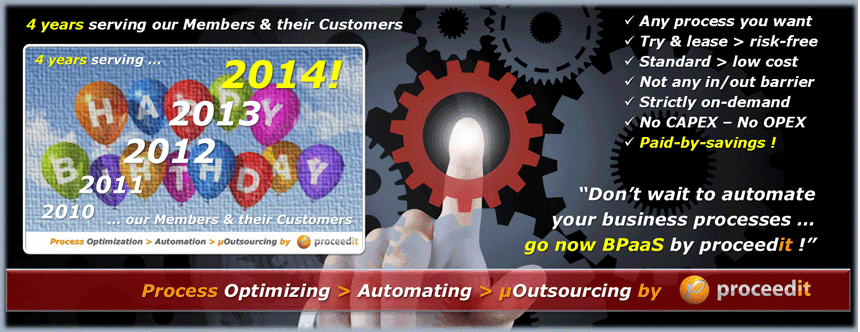As commented in
one of ours recent posts by "BPM
Adoption" we understand the way that some organizations have
undertaken to relieve, optimize, automate and outsource part of their business
processes with the ultimate aim of achieving and maintaining the Operational Excellence that ensure them
a sustainable competitive advantage.
To simplify our
analysis, we have grouped the various strategies of BPM Adoption usually followed by organizations in four archetypal
models, which we have called "Process
Team", "Cloud",
"Consulting" and "BPaaS".
Each model is
characterized by the decision organizations have made in terms of the Mode of Development of the automation
solutions, differentiating whether they do or plan to do by internal or
external means; and the Mode of
Exploitation of such automation solutions, differentiating if they do or
plan to do either on internal systems (on-premises)
or external (on Cloud or on an
external Data Centre).
The “Process Team” model we analyze in this
post could be considered the most "canonical" because the survey,
optimization, analysis, development and integration of automation solutions (Development Mode), and its subsequent
implementation and operation (Exploitation
Mode) is performed with internal resources, both in terms of technical
personnel and systems that must support new applications as is described in the
next figure:
Under this
model, organizations tend to create a team, section or internal department
specialized in the functions listed above, regarding the deployment of BPM Processes in the organization.
This team is
usually named as CoE "Centre of Excellence" or "Process Team" and traditionally, in
a first phase, devotes much effort (from one to three years, depending on the
size of the organization) to discover, map and describe the business processes that
the organizations are following, often using a BPA (Business Process
Analysis) type tool.
This process team
uses to depend functionally on the Organization,
Quality or Organization and Process Departments,
this latter one often is new created department. Rarely the dependency is under
the Information Technology Department or
equivalent.
This model is
often applied to large organizations and corporations whose resources allow them
to cope with and to amortize the large cost that represents maintaining said
operating unit.
Once the
organization has completed their business process mapping then decides the
development and implementation of a first automated business process. The main
external actor in this project uses to be the BPMS Vendor, and its vector is the BPMS Platform that the organization has chosen for the
configuration, development, integration, operation and maintenance of their BPM Processes.
The choice of
the BPMS Vendor and its technology is
strategic to the customer as it will be captive of them for many years, even
decades, and for being so huge the eventual migration costs and time required
for a technology change.
That is why
organizations that adopt this model tend to opt, among the two or three pure
first class BPMS Vendors or, alternatively, generalist market leaders Software
Vendors who incorporate BPMS Platforms
(usually acquired from third parties) in their value proposition; always taking
into account in making their decisions the analysis and recommendations that
provide technology analyst like Gartner, Forrester, ...
Automation
solutions are developed in a project under the direction of the customer itself,
even entirely with internal personal or, most of times, with a mix of internal
and external personnel; following in this way the traditional procurement model
of IT professionals that is being
known as "body shopping"
provided by companies called "Consultancy
Companies".
In this model,
the secondary external actor is the external consultancy company providing the
external consultants and technicians, adding value in terms of availability,
opportunity and flexibility like, for instance, the easiness of hiring and firing
technical staff outside the rigid internal people recruitment patterns that
these big organizations and corporations have established.
Traditionally,
organizations adopting this model, applications are exploited in Customer's
servers, option called "in-house"
or "on-premises", this creating
an increasing need for investment in equipment and high internal workload,
often not quantified or even hidden. From the basic software required side (operating
systems, database, BPMS Platform and
other complementary applications), it is customary to follow the license purchase
and annual maintenance modality.
For all the
above reasons, the “Process Team”
model is characterized by a high CAPEX (CAPital EXpenses) and OPEX (OPerating EXpenses) and only applicable and sustainable by big
organizations and corporations when we talk about massive BPM deployment projects.


No comments:
Post a Comment